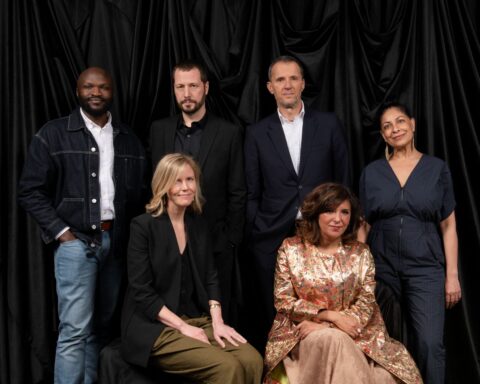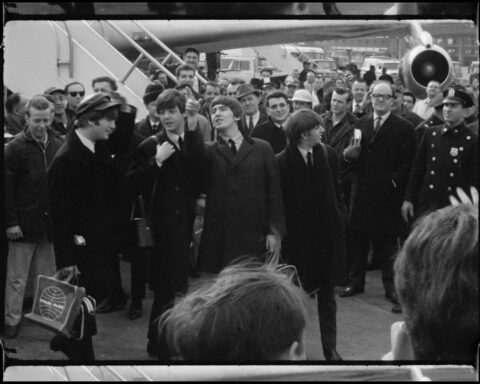In June 2016, Christo made his long-awaited return to large-scale environmental installation art with his project The Floating Piers. Conceived decades previously with his late wife and long-time collaborator Jeanne-Claude, who passed away in 2009, The Floating Piers were an ambitious project that saw Christo create an elaborate network of walkways atop Italy’s Lake Iseo. Grand pathways connected villages on either side of the lake as visitors could explore their environment from new perspectives as they strolled Lake Iseo atop Christo’s buoyant orange piers. The 83-year-old Bulgarian artist, whose full name is Christo Vladimirov Javacheff, found a bittersweet comeback in the popular installation, which drew an 100,000 visitors daily based on estimates by the local police.
Christo’s effort with The Floating Piers is captured brilliantly in the new documentary Walking on Water, directed by Andrey Paounov (The Boy Who Was a King, The Mosquito Problem and Other Stories). Christo’s stories have been documented countless times before, most famously in the films by David and Albert Maysles like Christo’s Valley Curtain (1974) and Christo in Paris (1990), but the cameras have never quite been privileged to such immersive and up-close views of Christo’s craft as they have here. Walking on Water draws from over 700 hours of footage shot during the construction of The Floating Piers — a daunting amount of material by any measure — yet Paounov gets right to the heart of his subject by capturing Christo’s energy as the project sees his return to form. It’s a delightful portrait of the fine madness entailed in the service of art: the passion, the dedication, the headaches, the flashes of inspiration. (Read the POV review of Walking on Water here.)
POV recently sat down with Paounov and Christo during the Toronto International Film Festival where Walking on Water enjoyed its North American premiere. The pair discussed the legacy of the Maysles and Christo’s work, the Herculean undertaking in the editing room, and the various artistic processes that inspire them as creators.
POV: Pat Mullen for POV
AP: Andrey Paounov
Ch: Christo
This interview has been edited for brevity and clarity.
POV: Andrey, I understand that this project came to you as 700 hours of footage. Who shot or commissioned the original footage?
AP: Christo always documents his projects. Documentation is always part of the art.
Ch: Yes, since the ’60s when we met Albert and David Maysles.
POV: When you first worked with the Maysles, did you pitch them the project?
Ch: I live in Paris. When Albert and David came to Paris in 1961 to show their films, we became very close friends. I had photographers following me at the time, taking pictures of the project for books, and we [the Maysles and I] became like a family. It was an incredible chance that they could film my work. I had no films before that. That is how everything started. David died [in 1987] and Albert passed away [in 2015] after The Gates project [2005]. Then I was alone. With my nephew and friends working together, we were very conscious that we had to film this project and have it covered by many cinematographers.
AP: I got into the project at the end of The Floating Piers. They had about 10 crews that were following Christo at different moments of the project. There were many crews: some were just doing aerial shots, some just following Christo, underwater cameras—there’s a lot that isn’t in the film.
POV: How did you decide which elements of the footage to distill into 100 minutes?
AP: That was the challenge of making the film. There was so much footage that it took me three months just watching it 10 hours a day, every day. There was no pre-concept or general direction in what the crews shot. We had no idea what was there. I had assistants and we were watching together, exchanging files, and finding out what was there. At one point, I started finding some tracks in the footage and what I was interested finding a character piece from all this chaos. Luckily, we live in the digital age, so there were days of cameras rolling, rolling, rolling, rolling. In between all this stuff, there were brilliant little pieces where you could see him and all the relationships with the family behind the Christo project. That’s how we started putting this puzzle together.
We also continued documenting his adventures. The end of the film [which sees Christo embark on a new project, The Mastaba] is something that we shot, but The Floating Piers was the other way around. It was like finding a suitcase of footage on the street.
POV: Christo, how has the evolution of technology changed the way people experience your work? Now everyone has a phone with a camera, talking selfies and putting the work on Instagram, etc.
Ch: You will see that I am not very technologically inclined. Of course, anyone can film, but the important part of all the films, especially this film, is that we were very conscious of filming a distinct period and the hard work. It’s very important when the physical project no longer exists. We never do the same things again. There will be no more Floating Piers, no more Valley Curtain. We do not know ourselves how the things will look. But we do know something: we know how to do it. All that work is so private and invisible for many people. We were very eager to show people what often isn’t seen by the public: the conflicts, the drama, the soul of the work. It is the reason I do not do commissions. All our projects over fifty years translate this energy when they are realized, not because some mayor of the city or corporate executive gives us some money to make a sculpture.
AP: But with the digital age, what has changed, especially since the previous films were made, is that the films were made in order to experience the project. Nowadays, it’s the opposite. We’re drowning in images. The Floating Piers destroyed Instagram there were so many images. I knew while making the film that I couldn’t just show the project as people had already seen it on TV, the news, and social media. I was also not interested in doing that because I’ve always felt that you have to make films about people and not things.
POV: How difficult is that when the project is about the creation of a thing?
AP: One of the things we were trying to do in the editing of the film was to cut out shots where you see the project. We wanted to show it only in the end. In the film, you really only see the project through Christo, not in solo shots of it.
POV: Were you intimidated by the prospect of tackling a subject like Christo whose work was captured in some documentaries that are now considered classics?
AP: Of course. It was hard to come and make sure that it wasn’t just a banal repetition of something that was done by somebody else before. I think that because of technology today, verité is so much different than the verité of the Maysles and Pennebaker working in the 1960s. Now it has a different approach. It was interesting to do a film in America and go through my influences. For the Christo film, I was not thinking so much about the Maysles as I was thinking of Don’t Look Back by Pennebaker. I was thinking, “How do you make this thing? What will this footage be like?” If I had to have a light in the sky to show me the way, I would go back to Don’t Look Back. They have a similar heart.
POV: And Christo, do you ever revisit the footage of the project and change your approach?
Ch: No, I never look at the footage. They were editing in the same building where I was living and I never looked at it. I’m doing so many things that I could not possibly be involved. We were working on the next project by then, which you see in the end of the film. They were already filming the next project during editing. I live the project. I enjoy it, with all the suffering, as part of my living.
POV: How was it working for the first time without Jeanne-Claude?
Ch: I miss her all the time. We were born the same moment of the same day of the same year. We’re twins, Geminis, as I say. She was an extremely critical person—sometimes we were fighting, arguing, screaming about how a project should be built. The most important work, as you see in the movie, is to see how simple is the thing, but extraordinary, and we found that together. Getting the permissions is a different story!
POV: And Andrey, from seeing this project, would you ever make a film that screened only once in the same way that The Floating Piers has a limited duration for people to experience?
AP: Yes, my previous films were made in Bulgaria/Eastern Europe and, as you know with documentaries, they often have trouble with distribution. On my last film The Boy Who Was a King, which was here at TIFF in 2011, I only made one exceptional screening in Bulgaria in the main hall of Sofia, which is for 5000 people. I spent one month promoting it and went to all the talk shows. I said, “I’m going to show this film only once and then you’ll never be able to see this film.” We had 2000 people who couldn’t come in. We sold 5000 tickets. If I had just put it into distribution in Bulgaria, it would probably sell 1000 tickets for three months. I think it’s very much a way to do things and add a sense that it’s exceptional, in the moment. That works with films as well.
POV: And what did you learn about yourselves as artists with this project?
AP: He taught me to walk on water!
POV: Maybe you should direct the story of Jesus Christ for your next film! And you, Christo?
Ch: Art is the most important thing in my life. I don’t like to argue, defend, or moralize. I’m absolutely against anything that’s propaganda—religious, political, environmental. Only humans can do art. That is an unstoppable urge. That cannot be justified by any sense of good or bad in art. Art is art.











